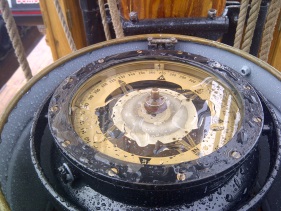Since 2001 two certified magnetic compass adjusters act according SOLAS and ISO:
- recommendation for selection and positioning of compasses and correction devices based on calculation and measurements
- initial and periodical compass adjustment
- assistance in degaussing system electrical compensation
- repair and exchange service
- investigation of compass failures
Compass adjuster John P. MARCUS was appointed as Approved Compass Adjuster by German Shipping Agency BSH under Register Nº 021.
Compass adjuster Peter BAHR was appointed as Approved Compass Adjuster by German Shipping Agency BSH under Register Nº 022.
The requirement for adjusting magnetic compasses derives from
A) SOLAS Chapter V Regulation 19 paragraph 2
2.1: All ships irrespective of size shall have:
2.1.1 a properly adjusted standard magnetic compass or other means, independent of any power supply to determine the ship’s heading and display the reading at the main steering position;
2.1.2 a pelorus or compass bearing device, or other means, independent of any power supply to take bearings over an arc of the horizon of 360°;
2.1.3 means of correcting heading and bearings to true at all times;”
B) ISO 25862:2009 Annex G
G1. General
A properly adjusted compass shall have a residual deviation within 3° in vessels 82.5m or more and 4° in vessels less than 82.5m. Accuracies shall be within 2° for safe navigation.
G2. Magnetic compasses should be adjusted when:
- they are first installed;
- they become unreliable;
- repairs or structural alterations have been made to the ship that could affect its permanent and/or induced magnetism;
- electrical or magnetic equipment close to the compass is added, removed or altered;
- the recorded deviation are excessive or when the compass shows physical defects;
- at any other time deemed necessary by the master for the safe navigation.
All magnetic compasses shall be swung and adjusted no less often than
- every two years (NBB comment or every year in case flag state requires)
- after dry docking
- after significant structural work.
G3. Compass Adjusters
Adjustment shall be carried out by a qualified compass adjuster.
G4. Adjustment by Flinders’ bars
Such adjustment shall include adjustment for all magnetic latitudes in which the ship may operate, so that the residual deviation after any change of latitude following the ship’s second periodic swing after new construction does not exceed 5°.
G5. Means to correct the heading to a true heading
Means to correct the heading to a true heading shall be available at all times. For example this means may be residual deviation table or curve and magnetic variation information.
G6. Description of the adjustment
The adjustment shall be carried out for the semi-circular and quadrantal deviations due to the horizontal components of the ship’s permanent magnetism; heeling error; the horizontal component of the induced horizontal magnetism; and the horizontal component of the induced vertical magnetism profitable devices respectively
G7. Deviation table or curve
Each magnetic compass is properly adjusted and its table or curve of residual deviations shall be available on-board in the vicinity of the display unit of the compass at all times.


